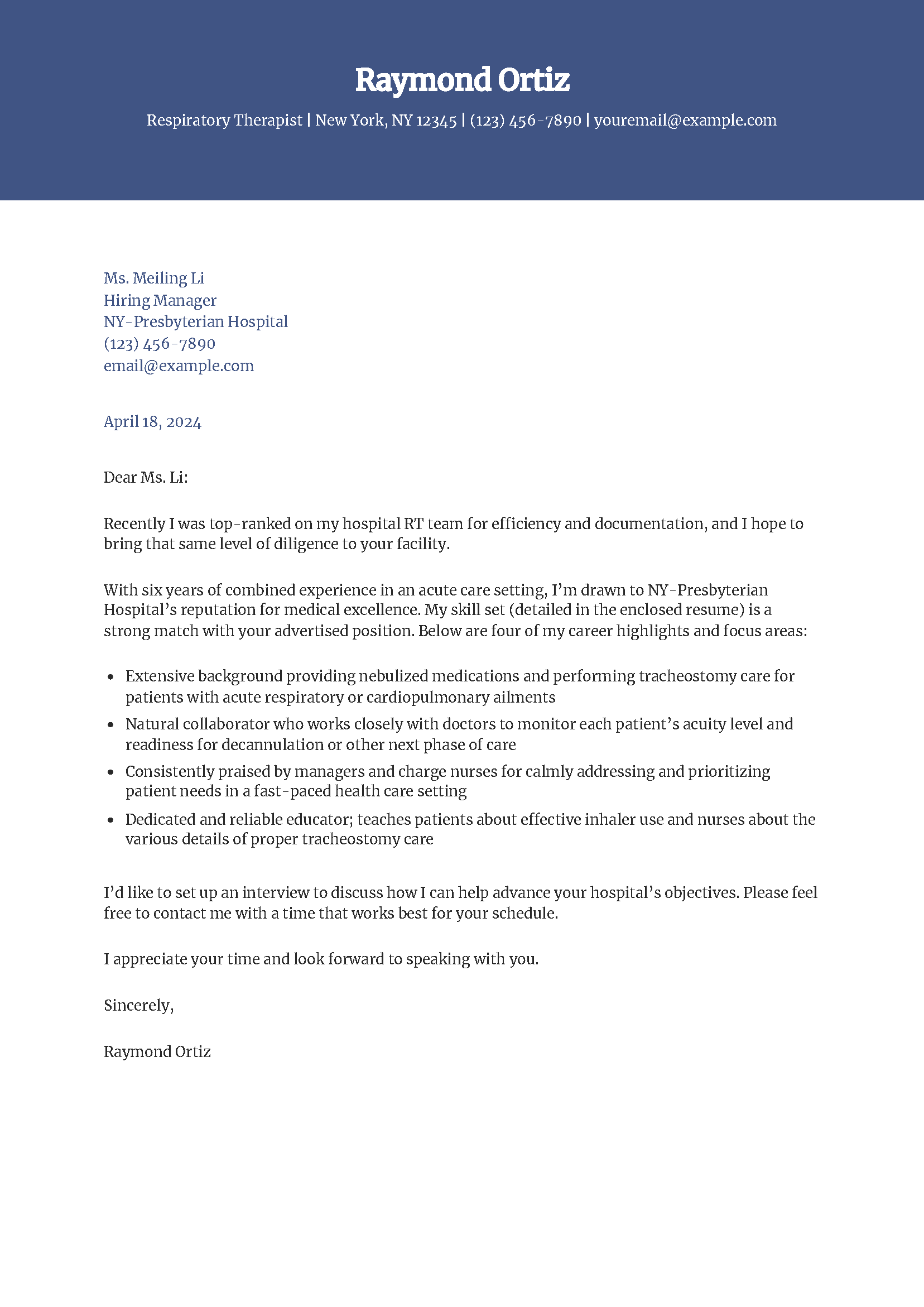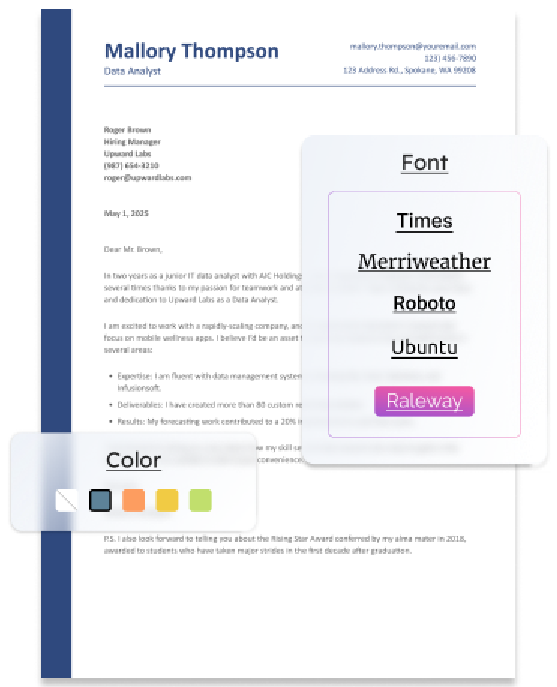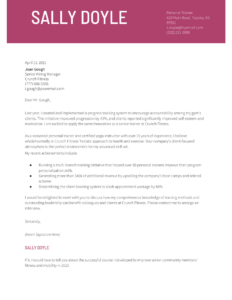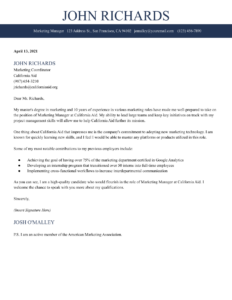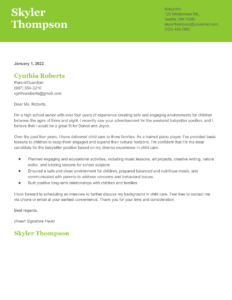Jobs for respiratory therapists are expected to grow by 13% between 2022 and 2032, according to the Bureau of Labor Statistics. If you want to explore opportunities in this fast-growing field, a strong cover letter can help.
With the cover letter resources below, you can:
- Download templates with strong text examples, whether you’re a new college grad or a seasoned veteran in your field.
- See an overview of the best cover letter structure, along with ideas for adding some flair.
- Learn tips for crafting a great letter for respiratory therapist openings.
Respiratory Therapist Cover Letter Examples and Templates
- Entry-Level
- Mid-Career
- Senior-Level
How To Write a Respiratory Therapist Cover Letter
A great respiratory therapist cover letter usually has five sections, outlined below. When possible, connect each section to your defining health care skills and the facility’s hiring needs. The following advice and examples show what to include in your cover letter so it’s optimized for each job application.
1. Heading
At the top of the page, include:
- Your name, title, and contact information. (Note, copying in your resume header helps keep a uniform presentation across your two documents. Always double-check your phone number and email address for accuracy — it’s as important as anything else on your application.)
- The date.
- The recipient’s name, title, health organization, and contact information (when available).
Example
Melissa Anderson
Respiratory Therapy Student | Philadelphia, PA 12345 | (123) 456-7890 | [email protected]
April 18, 2024
Ms. Lori Taylor
Hiring Manager
Thomas Jefferson University Hospital
(123) 456-7890
[email protected]
2. Salutation
Whenever you can, address your recipient by name — it’s the quickest way to signal you’re sending a job-specific letter and not a boilerplate. If you can’t find the recipient’s name, use a variation of “Dear Hiring Manager” so your greeting is still tailored somewhat to each job opening. (Never use “To Whom It May Concern.”)
Examples
Dear Ms. Li:
Dear NY-Presbyterian Hospital Hiring Manager:
3. "Hook" or introduction
Your introduction is where you express interest in the job opening, but more importantly, it’s where you should grab the reader’s attention. To do that, pick one of the top achievements listed on your resume and restate it in a clear, confident tone. Choose a highlight that speaks to your relevant professional strengths. Avoid offering generic facts like your years of experience or level of education.
Example
Recently, during my practicum at Roxborough Memorial Hospital, I was singled out as a top respiratory therapy student based on my eagerness to learn and collaborate on a team. I hope to bring that same dedication to Thomas Jefferson University Hospital as a respiratory therapist.
4. Body paragraph(s)
Begin the body of your cover letter by giving more detail on your interest in the hiring organization. Specify why you want this position — quoting text from the job posting can be a great way to catch the reader’s eye and show them you’re responding to their particular work opportunity.
Next, describe your relevant achievements or career highlights, which may include educational degrees or certifications, promotions, or successful projects you spearheaded. Consider using a list of bullet points to break up the text and help the hiring manager more easily see your top selling points. For each highlight you list, include a positive outcome to show the types of success you could bring to this new position.
Example
I’m drawn to your hospital’s reputation for medical excellence and to your stated focus on patient outcomes. My skill set (detailed in the enclosed resume) is a strong match for this opportunity. Below are four of my key qualifications:
- Bachelor’s Degree in Respiratory Therapy with honors from Temple University
- Experience providing nebulized medications and performing tracheostomy care for patients with respiratory or cardiopulmonary ailments
- Demonstrated success working with nurses and providers to monitor each patient’s acuity level and readiness for decannulation or other next phase of care
- Praised by preceptor and charge nurses for calmly addressing and prioritizing patient needs in a fast-paced setting
5. Call to action
Finally, request an interview and thank the hiring manager for their consideration. To end your cover letter, use a simple closing like “Sincerely” or “Best regards” and then your name.
Example
I would appreciate the chance to discuss how I can help advance your health care objectives. Please feel free to contact me with an interview time that works best for your schedule. Thank you for your time, I look forward to hearing from you.
Sincerely,
Melissa Anderson
Respiratory Therapist Cover Letter Tips
1. Mention your relevant traits
Desired qualities in respiratory therapists include compassion, focus, patience, and strong communication. Consider which of these traits describe you best, then give an example or two of how you’ve shown them in a health care setting.
Example
- Natural collaborator who works closely with doctors to set viable treatment plans and monitor each patient’s acuity level
2. When in doubt, brainstorm
Any time you’re stuck on a section of your cover letter, take 10 minutes to quickly jot down your thoughts on a separate document or sheet of paper. By pausing to think more creatively, you can jog your memory and find new details to include about your experience. Brainstorming also helps you figure out the best and most original way to describe that experience, giving your letter the confident tone it needs to catch a hiring manager’s attention.
3. Keep it concise
Limit your cover letter to one page, or around 250 words. Resist the urge to tell your whole career story, even if you have an extensive background as a respiratory therapist. Give just enough detail to pique hiring managers’ interest so they take a closer look at your resume.
Respiratory Therapist Text-Only Cover Letters
- Entry-Level
- Mid-Career
- Senior-Level
Raymond Ortiz
Respiratory Therapist | New York, NY 12345 | (123) 456-7890 | [email protected]
April 18, 2024
Ms. Meiling Li
Hiring Manager
NY-Presbyterian Hospital
(123) 456-7890
[email protected]
Dear Ms. Li:
Recently I was top-ranked on my hospital RT team for efficiency and documentation, and I hope to bring that same level of diligence to your facility.
With six years of combined experience in an acute care setting, I’m drawn to NY-Presbyterian Hospital’s reputation for medical excellence. My skill set (detailed in the enclosed resume) is a strong match with your advertised position. Below are four of my career highlights and focus areas:
- Extensive background providing nebulized medications and performing tracheostomy care for patients with acute respiratory or cardiopulmonary ailments
- Natural collaborator who works closely with doctors to monitor each patient’s acuity level and readiness for decannulation or other next phase of care
- Consistently praised by managers and charge nurses for calmly addressing and prioritizing patient needs in a fast-paced health care setting
- Dedicated and reliable educator; teaches patients about effective inhaler use and nurses about the various details of proper tracheostomy care
I’d like to set up an interview to discuss how I can help advance your hospital’s objectives. Please feel free to contact me with a time that works best for your schedule.
I appreciate your time and look forward to speaking with you.
Sincerely,
Raymond Ortiz
Respiratory Therapist Cover Letter Frequently Asked Questions
Do I really need a cover letter for my job search? -
Yes, in most cases. Job postings today usually require or allow you to send a cover letter along with your resume. While not every hiring manager reads or prioritizes them, a well-crafted letter can only help you stand out from other applicants. It will also help you clarify what points to emphasize during the interview.
Should I say “My name is…” on a cover letter?-
No. As long as your name appears in the letter’s closing section, you don’t need to state it otherwise.
What’s the difference between a resume and a cover letter?-
A resume may show you’re qualified for the job, but a cover letter shows you want it. More than repeating resume points, your cover letter should explain why the job caught your eye or the organization strikes you as a great fit, setting the stage for a positive interview. In this way, a good cover letter sharpens your application by letting you say directly what your resume can only indicate.
Craft a new cover letter in minutes
Get the attention of hiring managers with a cover letter tailored to every job application.
